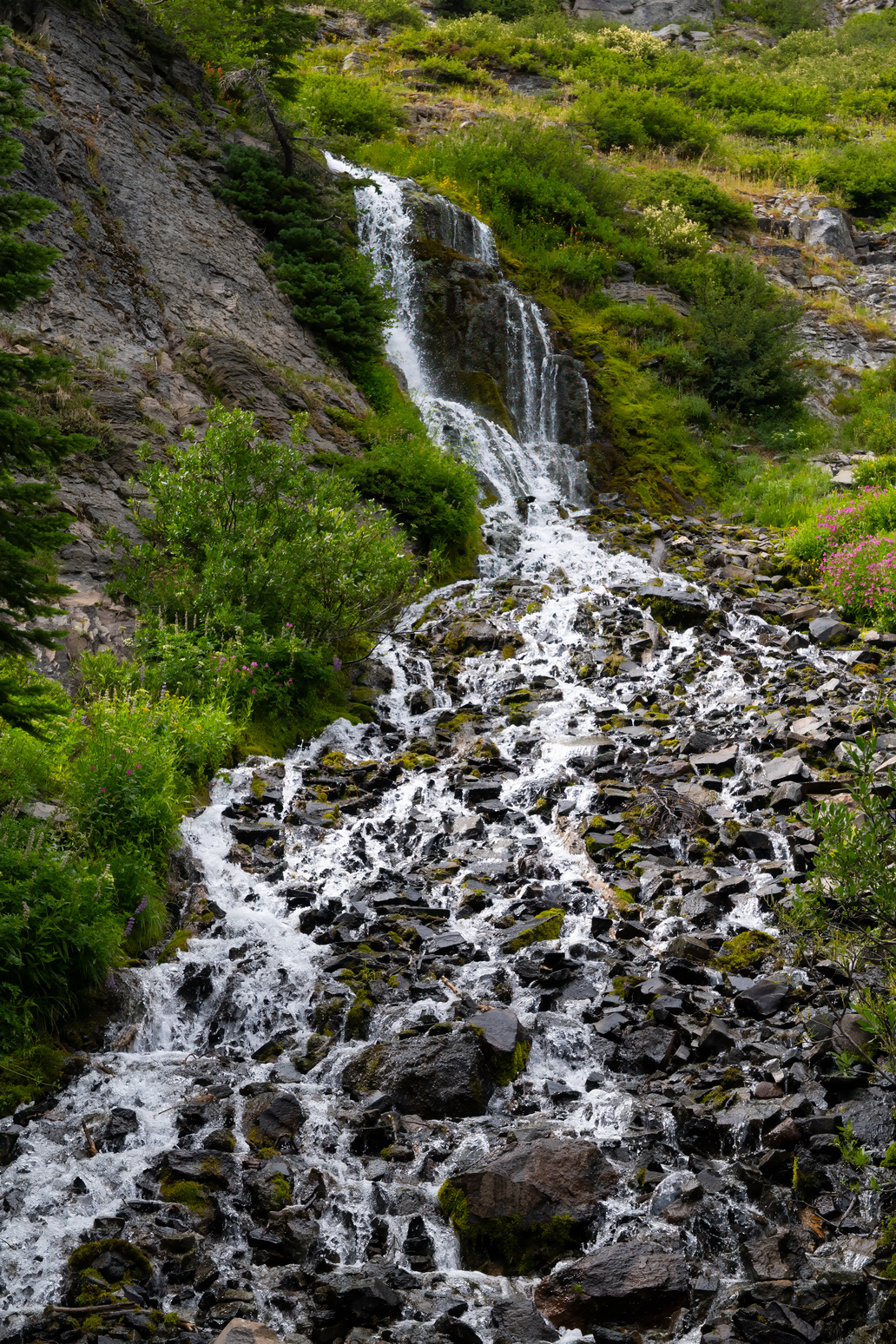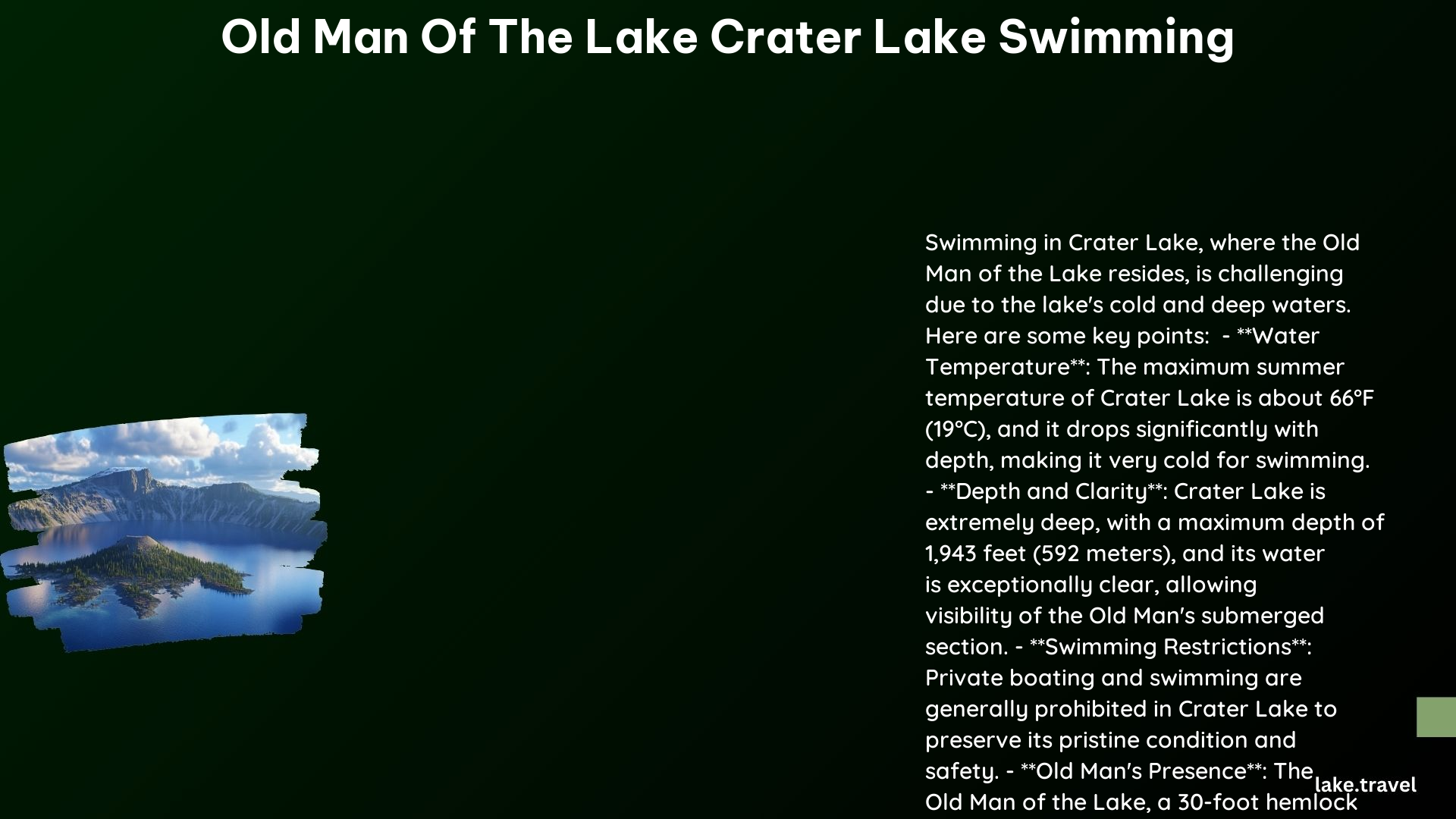The Old Man of the Lake at Crater Lake is a unique natural phenomenon – a 30-foot log that has been floating vertically in the lake for over a century. While swimming near this iconic landmark is not specifically permitted, Crater Lake does offer limited swimming opportunities. Visitors can enjoy the pristine waters at designated areas like Cleetwood Cove, adhering to strict regulations to preserve the lake’s ecosystem and ensure safety.
What is the Old Man of the Lake?

The Old Man of the Lake is a fascinating natural wonder that has captivated visitors to Crater Lake for generations. This peculiar phenomenon is a 30-foot mountain hemlock log that has been floating upright in the lake for over 100 years. First documented in 1896 by geologist Joseph Diller, the Old Man has become an iconic symbol of Crater Lake’s mysterious beauty.
Key facts about the Old Man of the Lake:
- Length: Approximately 30 feet
- Species: Mountain hemlock
- First documented: 1896
- Estimated age: Over 100 years
- Unique feature: Floats vertically with about 4 feet above water
The Old Man’s ability to remain upright is attributed to the dense root end being waterlogged, acting as a ballast, while the sun-bleached and weathered top portion remains above the water’s surface. This natural oddity has sparked numerous legends and scientific studies over the years, adding to the allure of Crater Lake.
Where Can You Swim in Crater Lake?

While swimming near the Old Man of the Lake is not specifically allowed, Crater Lake does offer limited swimming opportunities for visitors. The National Park Service has designated specific areas where swimming is permitted, ensuring both visitor safety and the preservation of the lake’s pristine environment.
Approved swimming locations in Crater Lake:
-
Cleetwood Cove: This is the primary and most accessible swimming area in Crater Lake. Located on the north shore, it’s reachable via a steep 1.1-mile trail.
-
Wizard Island: Swimming is allowed from the public boat dock when not in use by park boats. However, this is more of a docking area than a designated swimming spot.
It’s important to note that swimming is only permitted within 100 yards of these locations. Additionally, swimmers must maintain a distance of at least 50 feet from any boat, dock, or buoy.
What Are the Swimming Rules at Crater Lake?
Swimming in Crater Lake, including areas near the Old Man of the Lake, is subject to strict regulations to protect the lake’s ecosystem and ensure visitor safety. Understanding and following these rules is crucial for an enjoyable and responsible visit.
Key swimming rules at Crater Lake:
- Swim only within 100 yards of Cleetwood Cove and Wizard Island
- Maintain a 50-foot distance from boats, docks, and buoys
- No wetsuits, masks, fins, or other swimming accessories allowed
- No jumping or diving from cliffs or caldera walls
- No pets in the water
- No soap or shampoo use in the lake
These rules are in place to prevent the introduction of non-native species, protect the lake’s water quality, and ensure the safety of all visitors. Compliance with these regulations helps preserve Crater Lake’s unique ecosystem for future generations.
How Cold is the Water in Crater Lake?
One of the most striking aspects of swimming in Crater Lake is the water temperature. The lake’s frigid waters can be a shock to even the most seasoned swimmers.
- Average surface temperature: 55°F to 60°F (13°C to 16°C) in summer
- Temperature at depth: Near-freezing year-round
- Warmest period: Late August to early September
| Month | Average Surface Temperature |
|---|---|
| June | 50°F (10°C) |
| July | 55°F (13°C) |
| August | 60°F (16°C) |
| September | 58°F (14°C) |
The cold water temperature is due to several factors:
- The lake’s depth (1,943 feet at its deepest point)
- Limited sun exposure in the caldera
- Snowmelt and rain as primary water sources
Swimmers should be aware of the risk of hypothermia, even during short swims in the summer months. It’s essential to listen to your body and exit the water if you start to feel uncomfortably cold.
What Safety Precautions Should Swimmers Take?
Swimming in Crater Lake requires careful consideration of safety measures due to its unique environment and challenging conditions.
Essential safety tips for swimming in Crater Lake:
-
Be aware of altitude effects: Crater Lake’s rim is at 7,100 feet elevation. The high altitude can lead to quicker fatigue and dehydration.
-
Stay hydrated: Drink plenty of water before and after swimming to combat the effects of high altitude and dry air.
-
Know your limits: The cold water can quickly sap your strength. Don’t overestimate your swimming abilities.
-
Use the buddy system: Always swim with a partner and keep an eye on each other.
-
Watch for boats: Be aware of boat traffic, especially near docks and buoys.
-
Prepare for the hike: The trail to Cleetwood Cove is steep. Ensure you’re physically prepared for the hike back up after swimming.
-
Sun protection: The high altitude increases UV exposure. Use sunscreen and wear protective clothing.
-
Follow park ranger instructions: Always heed warnings and advice from park staff.
By following these safety precautions, visitors can enjoy a memorable and safe swimming experience in Crater Lake’s crystal-clear waters.
What Makes Swimming in Crater Lake Unique?
Swimming in Crater Lake offers a truly one-of-a-kind experience that sets it apart from other swimming destinations. The lake’s geological history, pristine water quality, and stunning surroundings contribute to its uniqueness.
Unique aspects of swimming in Crater Lake:
-
Clarity: Crater Lake is renowned for its exceptional water clarity, with visibility up to 100 feet deep.
-
Purity: The lake’s water is among the purest in the world, fed primarily by snow and rain.
-
Depth: At 1,943 feet deep, it’s the deepest lake in the United States.
-
Volcanic origins: Swimming in a caldera formed by a collapsed volcano adds a sense of geological wonder.
-
Limited access: The restricted swimming areas make it a rare and special experience.
-
Surrounding scenery: The caldera walls and forested rim provide a stunning backdrop for swimmers.
-
Presence of the Old Man: While you can’t swim directly to it, knowing the Old Man of the Lake is out there adds to the mystique.
These factors combine to create an unforgettable swimming experience that connects visitors with the natural wonders of Crater Lake National Park.
How Has Swimming in Crater Lake Changed Over Time?
The history of swimming in Crater Lake reflects changing attitudes towards conservation and park management. Understanding this evolution provides context for current regulations and appreciation for the lake’s preservation.
Timeline of swimming in Crater Lake:
- 1902: Crater Lake becomes a National Park, increasing public interest in the lake.
- Early 1900s: Unrestricted swimming allowed throughout the lake.
- 1930s-1960s: Boat tours often include swimming stops at various locations.
- 1970s: Growing environmental concerns lead to more restricted swimming areas.
- 1980s: Swimming limited to Cleetwood Cove and Wizard Island to protect water quality.
- Present day: Strict regulations in place to balance visitor access with ecosystem preservation.
This evolution demonstrates the ongoing effort to maintain Crater Lake’s pristine condition while allowing visitors to experience its unique beauty. The current swimming regulations are a result of decades of observation, scientific study, and a commitment to preserving this natural wonder for future generations.
What Do Visitors Say About Swimming in Crater Lake?
Visitor experiences provide valuable insights for those considering a swim in Crater Lake. While individual experiences vary, certain themes emerge from visitor reviews and testimonials.
Common visitor feedback:
- “The water is shockingly cold, but incredibly refreshing.”
- “The clarity of the water is unlike anything I’ve ever seen.”
- “The hike down to Cleetwood Cove is challenging, but worth it for the swim.”
- “I wish there were more areas open for swimming.”
- “Swimming in a volcano crater was a bucket list experience.”
- “The restrictions are understandable, but can be disappointing for some visitors.”
These diverse perspectives highlight the unique and sometimes challenging nature of swimming in Crater Lake. While the cold water and limited access can be drawbacks for some, many find the experience unforgettable and well worth the effort.
In conclusion, swimming in Crater Lake near the Old Man of the Lake offers a rare opportunity to immerse oneself in one of nature’s most pristine and awe-inspiring environments. While specific regulations limit where and how visitors can swim, these rules ensure the preservation of this unique ecosystem. By understanding and respecting these guidelines, visitors can enjoy a safe and memorable swimming experience in the shadow of the mysterious Old Man of the Lake.
References:
1. The Old Man of the Lake – National Parks Conservation Association
2. The Old Man – Crater Lake – National Park Service
3. Safety – Crater Lake National Park (U.S. National Park Service)
